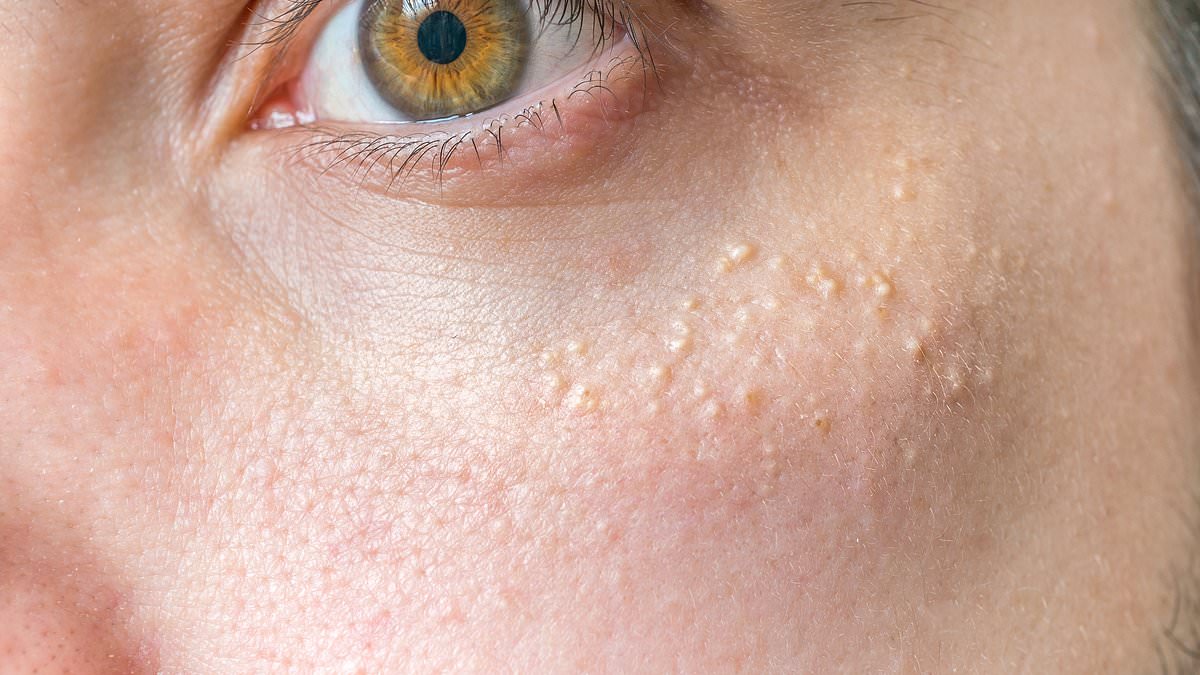How to get rid of unsightly white bumps under your skin: A cosmetic doctor reveals the fail-safe ways to banish milia spots, even if you’ve suffered with them since childhood
By Editor,Scarlett Dargan
Copyright dailymail

Many of us have those frustrating tiny white bumps clustered around the eyes, cheeks or nose that won’t budge no matter how much we cleanse or exfoliate. Often mistaken for whiteheads or clogged pores, these persistent little spots are actually milia – keratin-filled cysts trapped just beneath the skin’s surface.
What makes milia so maddening is how resistant they are to traditional treatments. While common skin issues like acne or blackheads will generally respond to over-the-counter products, milia simply sit there, immune to whatever we lather on them. They can affect anyone at any age, yet surprisingly few people understand what they’re dealing with or how to tackle them properly.
The confusion around milia means many of us end up throwing money at products that aren’t suitable or effective. These pesky spots need a considered approach – but without the right information, it’s impossible to know where to start.
To get the facts, we spoke to Dr Ross Perry, experienced aesthetic doctor and founder of the clinic Cosmedics. From the causes of milia to what actually shifts them (spoiler: it’s not what you’d expect), here’s everything you need to know about these stubborn skin bumps.
What exactly are milia and why do some people develop it?
Milia are small, white or yellowish cysts that often appear just under the surface of the skin, Dr Perry says. They’re most commonly found around the eyes, cheeks, and nose, though they can appear anywhere on the face.
Milia occur when keratin – a natural protein found in skin and hair – becomes trapped beneath the skin’s surface. This commonly occurs due to slow cell turnover, skin damage from trauma or injury, sun exposure or frequent use of thick face creams. Unlike spots or acne, they’re not caused by bacteria, excess oil, or poor hygiene, and they can’t be squeezed or extracted at home.
You don’t need to stress from a health perspective, Dr Perry says. Milia are completely harmless, but understandably frustrating from a cosmetic perspective.
And even better, they can be easily and safely removed by a doctor or trained practitioner, often using a fine sterile needle (less painful than it sounds, we promise!). Once removed, they tend not to recur in the same spot – but they could pop up in other areas if you continue the same pattern.
What are the main triggers of milia and which is the biggest culprit?
Annoyingly, some people are simply more prone to milia due to taking medications, autoimmune conditions or highly reactive skin. Trauma or irritation (anything from burns and rashes to scratches and cuts) can create pockets where keratin collects. Then there’s sun damage, which can thicken the skin and make keratin entrapment more likely. Milia are most common in newborns, but adults can develop them too, often as small clusters around the eyes and cheeks. Age can influence susceptibility, with some people naturally becoming more prone to developing these tiny cysts as they mature.
The biggest culprits, however, are heavy or occlusive skincare products, particularly when used around the delicate eye area. Rich creams, thick moisturisers, or oil-based products can clog pores and trap keratin just beneath the surface, leading to those stubborn white bumps. Even with otherwise healthy skin, regular use of heavy, oily or creamy products can make milia likely.
Which skin types or tones are most affected by milia?
Milia can affect all skin types and tones, and there is no particular group that’s immune. That said, certain factors can make some people more susceptible. Individuals with thicker skin might find keratin gets trapped more easily, while those with dry skin who require heavy moisturiser are also at risk.
In terms of skin tone, milia are generally visible on all tones, though Dr Petty points out they’re often more noticeable on lighter skin because the tiny white bumps contrast more with the surrounding skin. On darker skin tones, they can appear slightly yellow or flesh-coloured and may blend in more, which sometimes makes them less immediately obvious.
What really works for treating milia?
This is where people really waste time and money, Dr Perry warns, because milia don’t respond to creams, exfoliants, or at-home squeezing. Attempting to remove them yourself can make them worse, cause scarring, or lead to infection. The only reliable and safe way to treat milia is through professional extraction by a trained clinician.
In a clinic, a dermatologist or cosmetic doctor will use a sterile needle or a tiny surgical blade to open the surface of the skin and gently remove the keratin cyst. For some patients, laser or electrocautery can also be used, especially for stubborn or recurrent milia. Once removed, they usually don’t return in the same spot, although some people will notice recurrences in different areas over time.
After treatment, prevention is key. Using lightweight, non-comedogenic products, avoiding heavy creams around the eyes, and gentle exfoliation to get rid of dead skin cells can reduce the likelihood of new milia forming.
What’s the single most important step in preventing milia from appearing (or returning)?
The single most important step in preventing milia is to avoid heavy, occlusive creams around the eyes and cheeks. These rich or oil-based products can trap keratin just beneath the skin, creating the perfect environment for milia to form. By switching to lightweight, non-comedogenic skincare and ensuring your skin can breathe, you dramatically reduce the risk of milia appearing or returning, even if you’ve already had to have them removed professionally.



